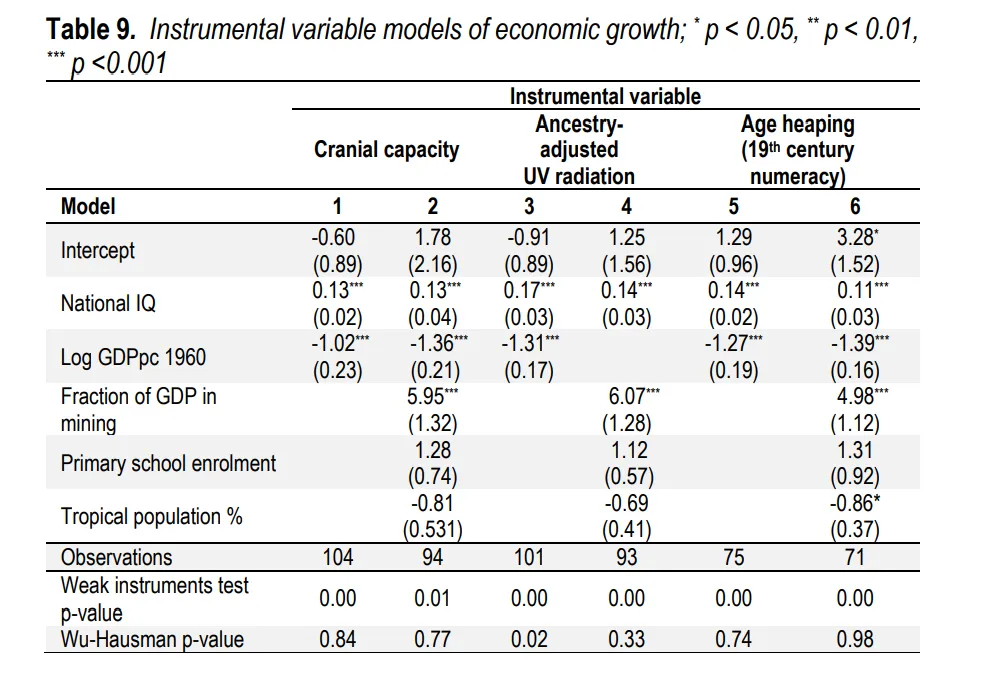
EDITOR’S NOTE: This is an opinion piece. The author’s views do not necessarily represent the opinions of ZME Science and its other staff.
What made today’s wealthiest nation so, well, rich? Is it the abundance of natural resources available for extraction within their borders? Is it isolation from costly and damning wars? Is it free, universal health care? It seems like an impossible question to answer because there are dozens of potential factors which intertwine leading to literally billions of billions of possible outcomes. But a pair of “academic mavericks” strongly believe they’ve cracked this puzzling grand question, using esoteric and quite questionable statistical modeling.
According to the new study, a nation’s average IQ is by far the most robust predictor of economic growth. Its effect is stronger — much, much stronger — than any other factor, including geography, system of government, the prevalence of diseases, population size, or education level. Every extra national IQ point was associated with a 7.8% increase in GDP per capita, we’re told. These results are supposedly robust regardless of the way you try to measure national intelligence, be it methods employed by the World Bank or the Organisation for Economic Cooperation and Development (OECD), say the authors.
This new analysis claims to compare the predictive strength of IQ against many other factors. And, perhaps most importantly, it found a causal link between national IQ and GDP, in this direction, meaning a population’s cognitive abilities seem to drive national wealth, rather than the other way around — or so they claim. If you’re scratching your head with a raised eyebrow right now, you are definitely not alone.
Does a nation’s average IQ really explain GDP? Oh boy, here we go
The new study, which hasn’t been peer-reviewed and will never be published in a respectable scientific journal, was authored by the highly controversial “independent” researchers George Francis from the UK and Emil Kirkegaard from Denmark. Each of them authored blog posts explaining their methods and findings (Francis and Kirkegaard), which quickly went viral on Twitter shortly after publication.
They start off by arguing that whenever economists have tried to find what drives economic growth, they’ve often come up short due to inherent biases and the complexity of all the dynamic factors involved. It’s common, they argue, to find an equal number of papers concluding democracy drives economic growth and that democracy doesn’t drive economic growth. This conundrum is known among economists as the “robust ambiguity”, meaning that different methods often give different answers about which factors promote economic growth. Faced with so many conflicting results, most economists have simply given up, finding the problem intractable.
But here come Francis and Kirkegaard, two beacons of science, arguing that a nifty statistical method known as Bayesian Model Averaging can help us reach a satisfactory conclusion to a question whose pursuit sensible scholars have long ago abandoned since it is of no actual scientific utility to pursue, nevermind in bad taste.
“There are 1000s of studies of economic growth, each using different measures of GDP, different sets of countries, different sets of controls to achieve their beloved p < .05 [editor’s note: p-value is a statistical measurement used to validate a hypothesis against observed data]. A lot of this is just plain cheating. They tried a lot of ways to fit a model until they found one that ‘worked’. There is a smart way to get around both of these problems: Bayesian Model Averaging (BMA),” Kirkegaard wrote in his blog post.
“The idea is to fit a lot of models without cheating. Millions of models in fact. If you have 200 predictors, there are 2^200 possible models, which is like a lot. You can’t fit all of those, as that would take approximately forever. But fortunately, you can pick at random from this population of models and try out, say, 5 million of them. Then you rank these models by their ‘model fit’ (R², BIC etc.), and then take a weighted mean of the best 1000 models. That is essentially what BMA does for you. Using the results from the 5 million models you fit, you could see the performance of a given predictor. Does it work well regardless of which other predictors are in the model? Does it always have the same sign i.e. direction of effect? Is it always found in the best models? If the answer to these questions is “yes yes yes”, then you have found a robust predictor.”
Francis and Kirkegaard didn’t set out to solve this problem from scratch. They piggybacked on a 2006 study authored by Garett Jones and W. J. Schneider that employed a database of national average IQ and showed that “in growth regressions that include only robust control variables, IQ is statistically significant in 99.8% of these 1330 regressions, easily passing a Bayesian model-averaging robustness test.”
In their new study, the Francis and Kirkegaard expanded upon this research by measuring how IQ performs relative to other predictors, then established a causal link — and in doing so employed much more dubious shenanigans than those they accuse genuine university professors of subscribing to, and whom they loathe so much.

“The left panel shows the probability that a given predictor was present in the best models (the PIP). 1.00 thus means 100%, it was always present. There’s only 2 variables that are always present. These are national IQ and GDP per capita in 1960. The latter variable is the advantage of backwardness mentioned above [editor’s note: a nation that starts out poor has the numerical advantage of growing relatively quickly]. The next predictor is natural resources in terms of mining. That one is basically just a matter of luck, and I guess not having environmentalist policies that prevent mining. Primary schooling enrollment also seems important. Being tropical is also a negative factor that seems important, but not much you can do about that aside from colonizing a new place to live, or maybe buying land,” Kirkegaard wrote in his blog post.
The strong predictive effect of national IQ on GDP stood out even after they employed multiple datasets, national intelligence estimates, BMA settings, and longer or shorter time periods. “National intelligence works every time pretty much,” Kirkegaard said. “No ambiguity here.”
Concerning the casualty of this relationship and its direction, the literature is abundant with studies showing how the daily stress of poverty reduces cognitive function. A 2013 study, for instance, found being preoccupied with money can cause low-income people to suffer a drop in IQ of 13 points on average. The reasoning that national IQ drives GDP is thus circular and obviously flawed. But this entire paper is one big mess.
To answer whether economic growth drives IQ or IQ causes economic growth, Kirkegaard and Francis use the so-called Instrumental Variable (IV) estimation. “This uses ‘instruments’ – variables that could increase growth through IQ, but could not have any reverse causality from economic growth,” Francis said on Twitter.
An Instrumental Variable (IV) is used to control for confounding and measurement errors in observational studies so that causal inferences can be made. It is a legitimate tool used in science to establish causal relationships, which can be particularly useful in epidemiology among other fields. The problem is the way the authors twisted IV to fit their obviously premade conclusions and racist views.
These said instruments included in the study were cranial capacity (what the heck?!), ancestry-adjusted UV radiation (a measure of geographical features, such as living in the tropics. Why though?), and 19th-century numeracy scores (YIKES!).
“For example, it is obvious that economic growth in the 20th century cannot influence numeracy in the 19th century. And by controlling for GDP per capita in the starting year, there should be no association between growth and 19th-century IQs, except through their effect on intelligence today. The IV estimates work by taking the effect of the instrument on economic growth and adjusting it for the instrument’s association with national IQ,” Francis wrote in a blog post.

Each of these instruments predicted economic growth, which is why they concluded that national IQ best explains economic growth and that this effect is causal — or so they claim. The study was published in full on ResearchGate (where anyone can publish anything that remotely looks like a study by the way).
Scientific racism in the 21st century
There are so many problems with this sort of investigation that I really don’t even know where to start. I’m just gonna say this much: this is all right-wing hogwash masquerading as science. The obvious implication of this ‘study’ is that some nations (read ‘races’) are genetically superior. Because said nations are superior, they are not only rich, but must, by extension, deserve to be rich.
It is a great stain on the institution of science that legitimate scientific methods have been malevolently used in the past — and sometimes fully in the present — to justify blatant racism. These include theories of the physical and intellectual inferiority of Blacks and Native Americans, which were likened to animals such as monkeys and apes. The epitome of pseudoscience used to justify racist beliefs is eugenics, which hinges on the idea that certain qualities are biologically more prevalent in certain populations, so the human species can be improved by selectively mating people with specific desirable hereditary traits.
But decades before Sir Francis Galton coined the term ‘eugenics’, Samuel George Morton published in 1839 what’s perhaps the most illustrative example of ‘scientific racism’, a book called “Crania Americana”. The book opens with an elaborate division of mankind into five fundamental races, before explaining how each race poses a particular character related to its skull shape. Morton wrote of Native Americans that “the structure of his mind appears to be different from that of the white man”.
This type of reasoning, quite popular in the 19th century, is known as phrenology, a pseudoscience whose central theme is to relate bumps in the head with personality traits. Phrenology was developed by a German physician named Franz Joseph Gall in the late 1700s. Gall noticed that the cerebral cortex of humans was much larger than that of animals, which he believed was what made humans intellectually superior. Eventually, he became convinced that the physical features of the cortex could also be seen in the shape and size of the skull.

Morton went a step further and applied this sort of reasoning not to individuals, but to whole races, after observing there were certain skull features that were a common function of race. Morton believed that cranial capacity, the size of the skull, gave an accurate measure of intelligence. The bigger your skull, the bigger your brain, the smarter you were, so Morton collected thousands of skulls and measured their cranial capacity. His study led him to claim, among other things, that Native American skulls were actually of a different consistency to Europeans, and went on to describe them as a whole as “adverse to cultivation, and slow in acquiring knowledge.”
I’ll leave you with some unsavory passages from Crania Americana.
EXCERPT FROM THE BOOK
Europeans
“The Caucasian Race is characterized by a naturally fair skin, susceptible of every tint; hair fine, long and curling, and of various colors. The skull is large and oval, and its anterior portion full and elevated. The face is small in proportion to the head, of an oval form, with well-proportioned features. . . . This race is distinguished for the facility with which it attains the highest intellectual endowments. . . . The spontaneous fertility of [the Caucasus] has rendered it the hive of many nations, which extending their migrations in every direction, have peopled the finest portions of the earth, and given birth to its fairest inhabitants. . . .”
Africans
“Characterized by a black complexion, and black, woolly hair; the eyes are large and prominent, the nose broad and flat, the lips thick, and the mouth wide; the head is long and narrow, the forehead low, the cheekbones prominent, the jaws protruding, and the chin small. In disposition the Negro is joyous, flexible, and indolent; while the many nations which compose this race present a singular diversity of intellectual character, of which the far extreme is the lowest grade of humanity. . . . The moral and intellectual character of the Africans is widely different in different nations. . . . The Negroes are proverbially fond of their amusements, in which they engage with great exuberance of spirit; and a day of toil is with them no bar to a night of revelry. Like most other barbarous nations their institutions are not infrequently characterized by superstition and cruelty. They appear to be fond of warlike enterprises, and are not deficient in personal courage; but, once overcome, they yield to their destiny, and accommodate themselves with amazing facility to every change of circumstance. The Negroes have little invention, but strong powers of imitation, so that they readily acquire mechanic arts. They have a great talent for music, and all their external senses are remarkably acute.”
Native Americans
“The American Race is marked by a brown complexion; long, black, lank hair; and deficient beard. The eyes are black and deep set, the brow low, the cheekbones high, the nose large and aquiline, the mouth large, and the lips tumid [swollen] and compressed. . . . In their mental character the Americans are averse to cultivation, and slow in acquiring knowledge; restless, revengeful, and fond of war, and wholly destitute of maritime adventure. They are crafty, sensual, ungrateful, obstinate and unfeeling, and much of their affection for their children may be traced to purely selfish motives. They devour the most disgusting [foods] uncooked and uncleaned, and seem to have no idea beyond providing for the present moment. . . . Their mental faculties, from infancy to old age, present a continued childhood. . . . [Indians] are not only averse to the restraints of education, but for the most part are incapable of a continued process of reasoning on abstract subjects. . . .”
It’s just mindblowing to me that someone would use the same exact reasoning, by which I mean relating skull size to intelligence, in the 21st century and have the nerve to seek recognition as a person of science.
Both Francis and Kirkegaard are not only lousy scientists but seem quite despicable human beings.
Francis and Kirkegaard have no academic affiliation. Instead, they post their right-wing pseudoscience on Substack.
I could barely find anything online on Francis, but his buddy Kirkegaard, who’s literally a neo-Nazi, is a real piece of work. The Rational Wiki has a 10,000-word exposée on him, thanks to the massive online footprint that Kirkegaard never bothered to cover up.
“Emil Ole William Kirkegaard (online aliases: Deleet,Deleetdk, EmilOWK) is a Danish far-right eugenicist, perjurer and activist for legalising child pornography and incest, as well as lowering age of consent. He has a wide range of crank views and is a global-warming denier, anti-feminist, ableist, anti-vegan, homophobe, Islamophobe, transphobe and has promoted white supremacy. He is most notorious and obnoxious online for his ableism and calling transgender people, liberals, feminists and pretty much anyone with left-wing political views who merely disagrees with him as “mentally ill”. Kirkegaard also argues dyeing your hair unnatural colours (such as blue) is associated with mental illness. Despite his own morally reprehensible writings on child porn and age of consent, Kirkegaard has a history of trying to link homosexuality to pedophilia as well as smearing left-wing people on his blog as pedophiles. Kirkegaard has re-tweeted “Opposing pedophilia is officially a right-wing position”.

“Kirkegaard denies and attacks anyone who points out he is alt-right and/or a white nationalist since he knows those things discredit his writings on race and intelligence; he self-describes himself alt-center, a term similarly adopted by Anatoly Karlin, Bo Winegard and several other crypto-fascist bloggers. The Southern Poverty Law Center monitors Emil Kirkegaard as part of their online hate watch.”
“As well as running Openpsych, Kirkegaard is the current domain owner of Mankind Quarterly, a racist pseudojournal rejected by mainstream science.”
“In 2013, there was a campaign by Danish Projekt Antifa to expel Kirkegaard from the Piratpartiet (Pirate Party) after they discovered he had ranted about “low IQ immigrants” on the Piratpartiet internet forum. Furthermore, on his Facebook profile, Kirkegaard posted a photo of himself next to someone performing a Nazi-salute, while smiling, and writing an insensitive comment about being the Führer. Antifa also found evidence that Kirkegaard had tried to defend the cooperation of the Piratpartiet with the neo-Nazi Party of the Danes, founded by Daniel Carlsen.”
“In May 2016, Aarhus University told Kirkegaard to stop lying about his employment as a “scientist”. At the time Kirkegaard was unemployed but falsely described his job as a “data scientist” on his Google Plus profile. Aarhus University published another statement clarifying “Emil Kirkegaard – he is not a scientist”.”
So why are we giving these two losers air time? Well, for one, they both have thousands of followers online so at least some people actually take them seriously. Perhaps some of these followers do some digging around and come to their senses. Secondly, this sort of fringe science and prejudice is quite common in some dubious corners of the web. What I mean is that these two clowns are not alone and there are entire communities of racist bozos congregating in online cesspools, which I’ll spare you from mentioning.


